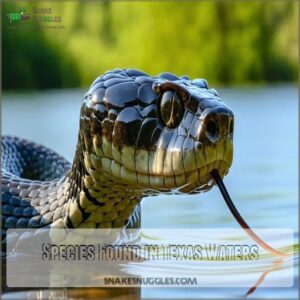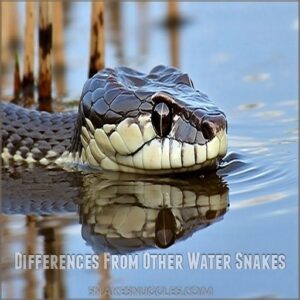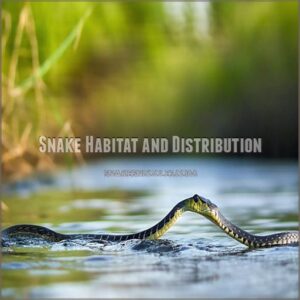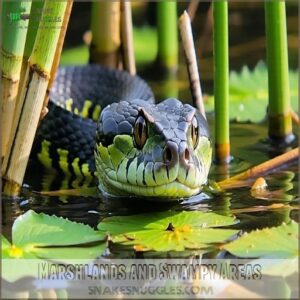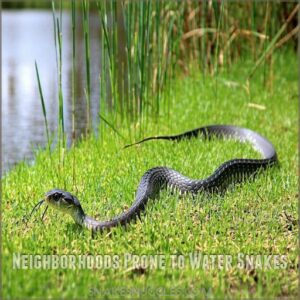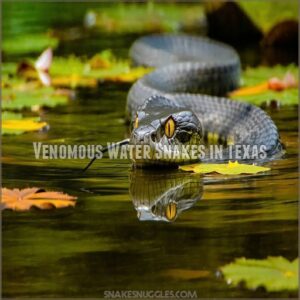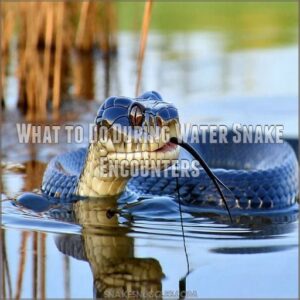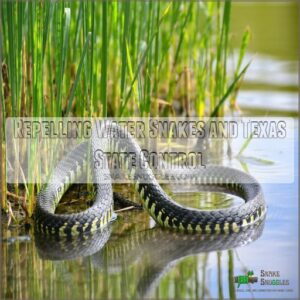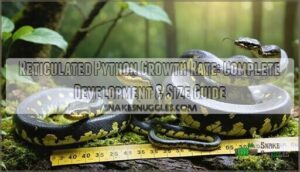This site is supported by our readers. We may earn a commission, at no cost to you, if you purchase through links.
 In Texas, water snakes thrive in a variety of wet habitats—from lakes and rivers to marshes and even urban waters.
In Texas, water snakes thrive in a variety of wet habitats—from lakes and rivers to marshes and even urban waters.
You’ll commonly find the Diamondback and Western Ribbon Snake, but be cautious—not all swimmers are friendly!
The Cottonmouth, a venomous cousin, lurks with a dark demeanor and a bite you’d rather avoid.
While enjoying Texas’s waterways, it’s important to tell them apart.
Remember, most water snakes are non-venomous and feast on fish and frogs, playing a key role in nature’s balance.
Want to explore without a hissy fit? Just keep an eye out for distinctive patterns and know your snake species!
Table Of Contents
- Key Takeaways
- Texas Water Snake Identification
- Where Are Water Snakes Most Common
- Venomous Water Snakes in Texas
- What to Do During Water Snake Encounters
- Repelling Water Snakes and Texas State Control
- Frequently Asked Questions (FAQs)
- Are water snakes in Texas poisonous?
- What does a Texas water snake look like?
- How to tell the difference between a water moccasin and a water snake?
- Are common water snakes aggressive?
- Can water snakes in Texas swim very fast?
- Do water snakes typically enter homes in Texas?
- Are Texas water snakes active at night time?
- Can you own a water snake as pet?
- How long do Texas water snakes typically live?
- How do water snakes affect local ecosystems?
- Conclusion
Key Takeaways
- You’ll often find water snakes in Texas‘s diverse aquatic environments, like lakes, rivers, and marshes. The Diamondback and Western Ribbon Snake are common, but be careful around the venomous Cottonmouth.
- Knowing how to identify different water snakes helps you avoid unpleasant encounters. Pay attention to patterns and features, as non-venomous water snakes look similar to their venomous counterparts.
- If you live near water, expect water snakes to occasionally visit your yard. Keep your space tidy and consider using natural repellents to deter them.
- In case of a snake bite, stay calm, get out of the water, and seek medical help immediately. Knowing first aid and having a bite kit can be lifesavers.
Texas Water Snake Identification
When identifying water snakes in Texas, you’ll encounter a fascinating variety of species thriving in its diverse aquatic habitats.
Distinguishing these snakes from other similar species involves observing specific features like size, color patterns, and their unique habitat preferences.
Species Found in Texas Waters
Imagine this: you’re wandering around the lakes and rivers of Texas, where water snakes, like the Diamondback Water Snake and western ribbon snake, thrive.
They range from tiny to quite large, feeding primarily on fish and amphibians.
You’ll find these slippery creatures in marshes or urban waters.
Watch your step; they’re critical to the ecosystem’s balance.
Differences From Other Water Snakes
Identifying Texas water snakes can be tricky. Size and color vary wildly between species.
You can find products to aid in water snake identification, such as field guides and visual tools, on websites like Water Snake Identifiers.
The Diamondback, for instance, is slender with a distinctive diamond pattern. The Cottonmouth, however, is thicker and darker, a real grumpy-looking snake.
Knowing these differences helps you avoid a potentially unpleasant encounter.
Snake Habitat and Distribution
Texas waters host diverse snake habitats, including the non-venomous Diamondback and the venomous Cottonmouth.
The Diamondback roams widely, avoiding only Texas’s west and Panhandle.
Meanwhile, the Cottonmouth thrives in East Texas, the Dallas/Fort Worth areas, and southern shores.
These water snakes adapt to a variety of environments but face threats like habitat loss, emphasizing the need for conservation efforts. Texas waters host a variety of snakes, including Diamondback and Cottonmouth.
Where Are Water Snakes Most Common
You might think of a water snake as a lake or river dweller, but in Texas, they pop up in surprising places like marshy swamps and even some neighborhoods.
Texas has diverse aquatic habitats, so understanding where these snakes are most common helps you safely explore the state’s natural beauty without any slippery surprises.
Popular Texas Lakes and Rivers
If you’re fishing or boating in Texas, watch for water snakes at popular spots like Lake Texoma, Guadalupe River, and Lake Livingston.
These waterways teem with local wildlife and are prime aquatic habitats.
Keep an eye out at boat ramps and while enjoying clear waters, ensuring both fun and safety during your adventure.
Marshlands and Swampy Areas
Exploring Texas’ marshlands and swamps? You’re in water snake territory, where these critters revel in humid, aquatic habitats.
Species like Cottonmouths thrive here, basking in sunlit patches.
Always stay alert when hiking or fishing to avoid any slippery mishaps.
Respect these lush ecosystems, and you’ll share the space peacefully with the locals of the swamp.
Neighborhoods Prone to Water Snakes
Living near water increases your chances of spotting water snakes, especially if your neighborhood features storm drains, frequent flooding, or lakeside parks.
Golf courses with ponds and neglected yards can also attract these slippery visitors.
Areas known for past sightings or infestations often see more activity, blending snakes seamlessly into Texas’ vibrant aquatic habitats—from rivers to lakes.
Venomous Water Snakes in Texas
In Texas, your path might cross with the Cottonmouth, the only venomous water snake in North America that thrives in diverse aquatic habitats.
Spotting these strong swimmers can be tricky, so it’s important to learn about their habitats and how to identify them safely.
Cottonmouth Snakes and Water Habitats
Texas waterways hold a secret: cottonmouths.
These venomous snakes are strong swimmers, often found near water.
Their bite packs a punch—pain, swelling, breathing trouble.
Having a Cottonmouth Snake Bite Kit on hand can be a lifesaver.
They can be aggressive if threatened.
Identifying them is tricky; they’re masters of disguise.
Respect their space to stay safe.
Learning about their diet, reproduction, and behavior helps you avoid these dangerous snakes.
Eastern Coral Snake Habitats and Characteristics
When you’re out enjoying Texas’s waterways, watch out for the Eastern Coral Snake. These colorful, venomous snakes might look like harmless critters, but their venom packs a punch. They feast on small mammals and reptiles, reproducing mainly in spring and summer.
Here are some quick facts about these elusive creatures:
- Coral Snake Identification: Red, yellow, and black bands set them apart.
- Eastern Coral Snake Diet: Mainly small mammals and reptiles.
- Coral Snake Reproduction: Spring and summer are their active breeding seasons.
- Coral Snake Conservation: While not endangered, habitat preservation benefits other species too.
Stay alert and safe out there!
Sea Snakes and Ocean Environments
Sea snakes are intriguing yet elusive in Texas waters.
They prefer Pacific coral reefs and are adept at riding ocean currents for hunting eels and fish.
Although their venom is quite potent, they don’t inhabit the Atlantic, providing Texans a sense of relief.
So, while water snakes are common, sea snakes remain a distant fascination.
What to Do During Water Snake Encounters
When you encounter a water snake in Texas, stay calm and slowly back away if possible, ensuring you give the snake plenty of space.
Knowing how to recognize these non-venomous and venomous snakes helps you respond appropriately, minimizing risk to both you and the snake.
Precautions When Swimming in Lakes or Rivers
Diving into Texas lakes or rivers means keeping an eye on the neighborhood critters.
Water snakes, including the infamous cottonmouth habitats, enjoy these spots too.
For water safety, buddy up while swimming and steer clear of thick plants or rocks where snakes might lurk.
Stick to the rules and keep your eyes peeled to avoid any slithery surprises.
Keeping Water Snakes Away From Home
Keeping water snakes out of your yard doesn’t have to be tricky!
Start with snake-proof landscaping: clear debris and use snake-repelling plants like mint or lemongrass.
Maintain gardens well; these critters aren’t fans of tidy spaces.
Remember, it’s about creating an unwelcome environment.
With these simple steps, you can enjoy your yard without worry about water snake encounters.
Response to a Snake Bite in or Around Water
In the splash of the moment, snake bites around water can rattle anyone.
First, stay calm and exit the water pronto.
If you’re prepared, you might’ve a Texas water snake bite kit on hand.
Remove tight rings or watches.
Key steps: 1. Call 911 ASAP.
- Capture snake details—a photo helps.
- First aid: Keep your limb low, still, and the wound clean.
Seek medical care without delay.
Repelling Water Snakes and Texas State Control
You’ll learn about safe and effective ways to deter water snakes from your property, from simple home remedies to understanding Texas’s role in managing snake populations.
This section also explores whether professional help is necessary and what state resources might be available.
Non-Professional Deterrent Methods for Snakes
Water snakes beeline for clutter like it’s an invite to a reptile party! Trim the chaos with snake-proof gardens—keep it tidy.
To boost your safety, consider consulting local snake identification resources.
Plant natural repellents such as mint or basil to spice up your battle plan.
Shake up your home strategy with DIY deterrents like hot pepper sprays.
Don’t forget to lock down bird feeders and pet food—snakes love a free buffet.
Extermination Methods in The Home and Property
Got water snakes sneaking around your property?
Consider installing snake-proof fencing to halt their slithering invasions.
Humane removal or DIY traps offer safe capture.
Professional help or repellents offer extra peace of mind, especially near water spots.
This approach helps manage both venomous and nonvenomous snake species, keeping your home and family safe from unwelcome visitors.
Programs in Texas to Eradicate Harmful Species
Dealing with snakes in Texas doesn’t have to be a solo mission.
The Texas Parks and Wildlife Department tackles invasive species, ensuring you’re safe near lakes and rivers.
Snake control measures aren’t just about handling the Cottonmouth or Diamondback Water Snake but also focus on wildlife management and public safety.
It’s all about keeping your outdoor adventures safe and snake-free!
Frequently Asked Questions (FAQs)
Are water snakes in Texas poisonous?
Curious critters, cottonmouths are the only venomous water snakes in Texas.
They’re mostly misunderstood among non-venomous neighbors like Nerodia species.
Spotting these slithery swimmers requires cautious curiosity, as misidentifying them can lead to some toothy trouble.
What does a Texas water snake look like?
Texas water snakes’ appearances vary widely. Some are slender and green, others thick-bodied with dark blotches. Size ranges from a foot to over eight feet! Coloration depends on the species.
How to tell the difference between a water moccasin and a water snake?
Look for differences in the head shape and swimming style.
The water moccasin has a triangular head and swims with its body mostly submerged,
while non-venomous water snakes have rounder heads and swim with bodies visible.
Are common water snakes aggressive?
Common water snakes aren’t typically aggressive but will defend themselves if threatened.
They might hiss or emit a foul odor as a warning.
Their bark is worse than their bite—humans usually aren’t on the menu!
Can water snakes in Texas swim very fast?
Picture water snakes slicing through water like nature’s torpedoes.
They swim quickly, not with speed demon fury, but confidently enough to catch prey or escape threats.
While not sprinters, their agility in water guarantees safety and survival.
Do water snakes typically enter homes in Texas?
It’s rare for water snakes to slither into your Texas home, but curious ones might sneak in if there’s food or water.
Ensuring secure doors and windows, and decluttering can help prevent these occasional visits.
Are Texas water snakes active at night time?
Texas water snakes show diverse activity patterns.
Many, like the Diamondback water snake, are primarily diurnal but can be active in low light.
Meanwhile, Cottonmouths are known for significant nocturnal activity, venturing out under the stars.
Can you own a water snake as pet?
Owning a water snake can feel like swimming with sharks in terms of necessary care.
While non-venomous water snakes are legal in many places, always check local laws and be prepared for specialized care requirements.
How long do Texas water snakes typically live?
Lifespans vary greatly among water snake species.
Some live only a few years, while others may survive for a decade or more.
Their environment and individual health play a big role.
How do water snakes affect local ecosystems?
Imagine a pond without water snakes—it might overflow with frogs.
Water snakes keep ecosystems balanced by controlling prey populations like fish and frogs, promoting biodiversity, and serving as prey for birds and mammals, ensuring a thriving local habitat.
Conclusion
Like a well-tuned orchestra, understanding water snakes in Texas requires knowing the distinct contributions each species brings to their ecosystem.
By recognizing their patterns and habitats, you can safely enjoy the beauty of Texas’s waters.
With this knowledge, avoid the venomous kinds and protect your home from unwelcome guests.
Respect these creatures, because they’re key players in maintaining nature’s balance.
Stay informed and secure, ensuring smooth encounters with Texas’s water snakes.

